Photographs of different types of cavitation
© 1996, S.A. Kinnas - About these photographs
Click on thumbnails for enlargement and explanantion:
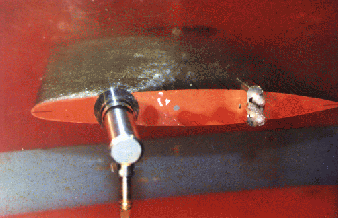

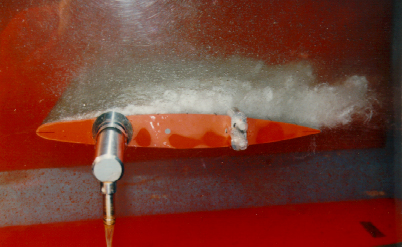
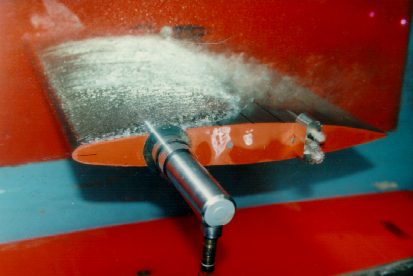
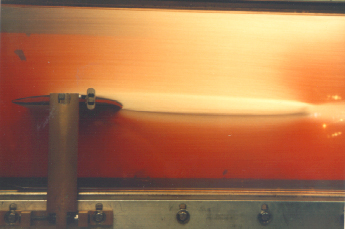

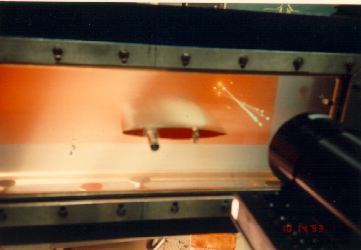
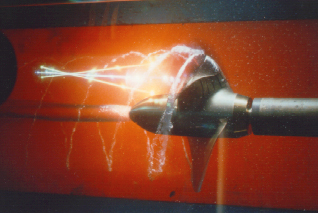

Partially Cavitating Hydrofoil

Here we see a hydrofoil exhibiting partial cavitation. A hydrofoil is a
"lifting" surface. It is like an airplane wing in that it provides
lift when a fluid flows past it. Both an airfoil and a hydrofoil create
lift by creating a low pressure on the upper surface. In the case of the
hydrofoil though, the pressure can become so low that the liquid water
transforms into a gaseous water (cavity). The study of cavitating hydrofoils
is important for research in the propulsor industry because a propeller
is nothing more than a few hydrofoils "wrapped around" a hub.
Click for
a close-up of a sheet cavity.
Partially Cavitating Propeller/Tip Vortex Cavity

This propeller is also exhibiting partial cavitation. The amount of
cavitation that occurs on the blade usually depends on the
position of the blade in it rotation. Usually the most cavitation
occurs when the blade is near the top of its rotation. Research in this
field is important because cavitation can cause excessive vibrations, noise,
and degredation of the propeller blade. The efficiency of a propeller will
also be compromised. Notice the thin string-like cavity near the tip of the blade.
This is called a (developed) tip vortex cavity
A Walk in the Clouds

This hydrofoil exhibits "cloud cavitation" Cloud cavities present
modeling difficulties because they tend to be unstable. It is also difficult
to hydrodynamically model the flow around a "cloud".
Bubbles!

This foil exhibits a fairly clean "sheet" cavity. Although near
the end of the cavity, you may notice some "bubble" cavitation.
Notice that the cavity does not begin at the leading edge of the foil.
(The leading edge is the very front of the foil.) Efforts are underway
to correctly model cavitating propellers with non leading edge detachment.
It's a bird! It's a plane! It's SuperCavity!

Here we can see a hydrofoil undergoing "super cavitation"--the
granddaddy of all cavities! A partial cavity becomes a super cavity when
it extends beyond the end of the foil (or blade in the case of propellers).
It's my Dream

This cavity is a clear example of sheet cavitation. Sheet cavities are
a hydrodynamicist's dream come true. They present the least modeling
difficulties.
It's my Nightmare

This hydrofoil is exhibiting a rare form of cavitation. Notice that there
are two cavities on the foil. This is the hydrodynamicist's
nightmare. The cavity near the leading edge of the foil forms and
then collapses quickly. Then, a "mid-chord" cavity forms
at about halfway down the hydrofoil. It is possible to model
mid-chord cavities or leading edge cavities alone, but a combination
of the two has not yet been attempted by our research group.
Hub Vortex

This photograph shows a cavitating propeller. You can clearly see
the tip-vortex cavities. Also present is a "hub-vortex" cavity
originating from the tip of the hub of the propeller. Research
on these forms of cavitation is underway.
Shark Attack

Here is a partially cavitating eliptical hydrofoil. This hydrofoil shape
is one step closer to an actual propeller blade.


























